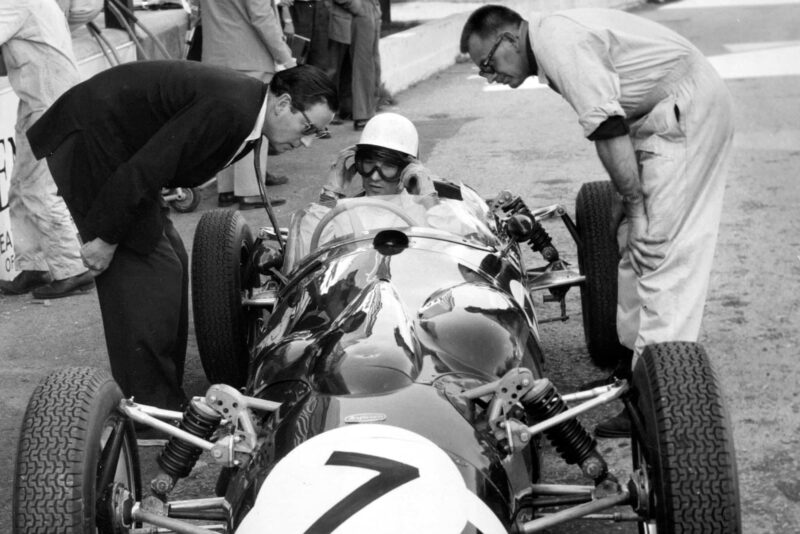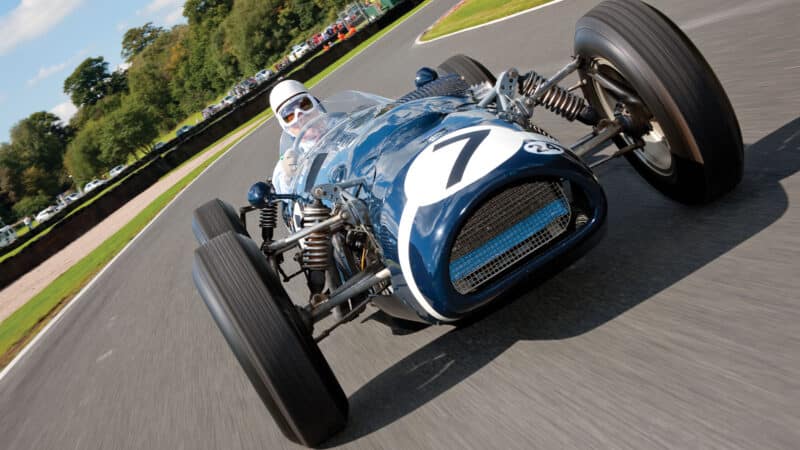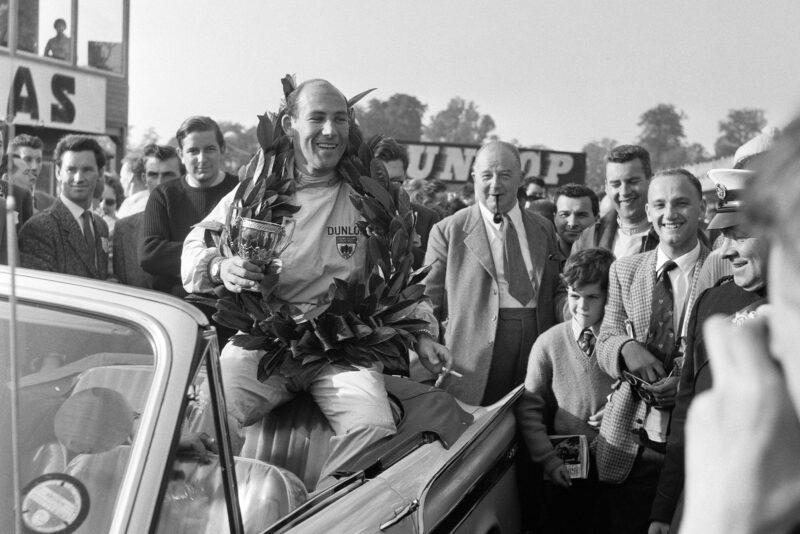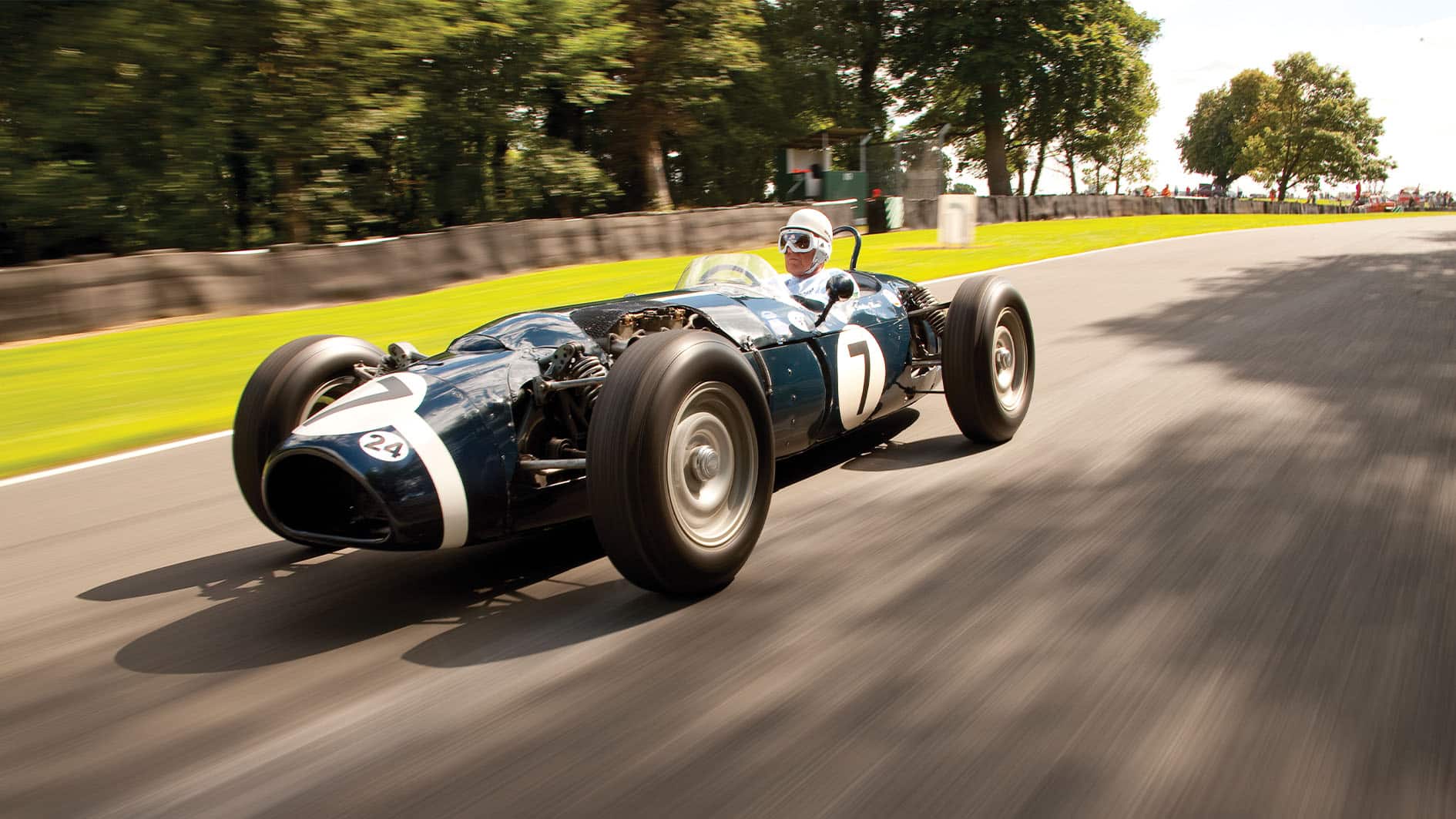Stirling Moss and the Ferguson P99: the experiment that struck Gold
When Stirling Moss raced the four-wheel-drive Ferguson to Gold Cup glory, it seemed the future was here… Almost half a century later, we reunite man and machine at the scene

Moss reunited with unique Ferguson P99
Tim Howell
“Okay. But please ask the announcer to tell the crowd why I’m not waving.” Sir Stirling Moss – the original professional racing driver and at the age of 80 still keenly aware not only of today’s job but also his duties to his public. We’ve brought him together with a special car, a machine with a unique place in racing history, and we want pictures. That means asking him to trail a camera car at a frustrating speed, and not wave until we’ve got our snaps. It’s hard for him – everyone on the banks treasures that wave as a personal greeting and he knows it – but it’s only for one lap. After that, Stirling, go as fast as you want, wave as much as you like. He does, and he does, and the crowd love it.
It’s the Gold Cup, now Oulton Park’s major historic meeting, but once a prime Formula 1 race in the days when they weren’t all bound to the championship. And Stirling was the master, winning it five times in four different makes of car. It’s the last of those wins we’re here to applaud, when he jumped into an experimental machine with little racing behind it and pulled off something which remains unique to this day – the only Formula 1 victory in a four-wheel-drive car. Almost 50 years on that vehicle, the Ferguson P99, has returned to Oulton Park, and, thanks to Motor Sport, Sir Stirling is driving it.
Around the circuit the banks are packed. In the pits the track director tells me this may be the biggest crowd the Cheshire track has ever seen; they’ve even had to close the paddock gates. Run by the HSCC, this huge meeting has drawn 480 cars from buzzing 500s to thundering F5000s, and if the range of races wasn’t enough, The Legend has entered his OSCA in a race called the Stirling Moss Trophy. Everyone wants an autograph or a photo. Every time he moves Moss is attended by a comet tail of fans; when he stops the programmes appear and he signs patiently, nodding and smiling to those who aren’t getting an autograph. If rarity mattered his John Hancock wouldn’t be worth diddley, but that’s not the point. It’s to be able to say ‘I met him’.

Moss discusses set-up with APR Rolt (left) and Alf Francis
Getty Images
There’s a respite for him at the Motor Racing Legends corral, where he’s having a quiet (until I interrupt) coffee with Susie Moss and Jamie Sheldon who has brought P99 from the Ferguson family museum at Yarmouth, Isle of Wight.
Sheldon is grandson of the P99’s progenitor, the creative Irish engineer Harry Ferguson who built and flew a pioneer aeroplane, reinvented the plough and the tractor, won a lawsuit against Henry Ford and lost $1 million on the toss of a coin (business, not gambling). But though his ‘little grey Fergy’ would at one point comprise three-quarters of all the tractors in Britain, Ferguson himself became increasingly interested in the safety benefits of all-wheel drive for road vehicles.
In 1948 he had backed ‘The Crab’, an all-steering, all-driving race project schemed by fiery racer Freddie Dixon and Tony Rolt, engineer and Le Mans-winning driver. Two years on he founded Harry Ferguson Research, and both men joined him, along with Claude Hill, designer of Aston Martins. And though that sounds like the recipe for a race team, the aim was primarily to bring all-wheel-drive safety to the road. By 1959 Ferguson’s prototypes had reached the R5 estate, which with 4WD, Dunlop Maxaret antilock disc brakes and a hatchback was 30 years ahead of any Audi Avant. But at a time when heaters were optional and ‘safety features’ meant padded sun visors, British makers – tiny Jensen apart – flocked to ignore it. 4WD was for Land Rovers only. Ferguson needed a high-profile billboard to demonstrate that, thanks to the crucial viscous coupling apportioning power smoothly front to rear, a Ferguson Formula-equipped car could also be a high-performance machine. And there’s nothing with a higher profile than Formula 1…
With Rolt as technical chief (Dixon had baled out by now) P99 was rapidly readied for the 1961 season. There was nothing unconventional about the racing car side of it: tube frame designed by Hill, all-wishbone suspension, the same Climax four most teams chose for the new 1½ litre formula, though as it was originally designed to the 2.5 rules it could also accept the bigger Climax to run in the short-lived Inter-Continental series. To eliminate bump-steer and joint plunge the lower arms are in line with the driveshafts, hence the high and slightly inelegant spring turrets. Packaging meant the block was canted over and the propshaft pushed the driver off to one side, but many cars had gone that route before in the quest for low seating. Putting the engine up front was more surprising, but it offered the desired 50:50 weight distribution for the 50:50 torque split, and of course the traction of 4WD would negate that advantage of rear engines. Speaking of weight, this was not automatically higher for 4WD: spreading the drive means lighter shafts, while inboard discs mean the shafts take the braking loads, allowing lighter suspension arms. In fact the P99 compared well with its rivals from Cooper and BRM.
Inevitably the 4WD system is bespoke, which might have made things difficult when after a long rest period the time came for restoration in 2004. Luckily the man who tackled the job is looking after it here at Oulton today, and once he’s warmed it up and it’s sitting ticking quietly in the garage waiting for Stirling to arrive, he talks me through the 18-month project.
“It hadn’t run since 1969, but there wasn’t much wrong with it,” says Barry Snow. “Fatigue in a couple of driveshafts so we had to make new ones, but otherwise the car today is as it was raced in 1961. Stirling has a waiver to drive it without harnesses or extinguisher.”
Snow’s Calbourne Garage on the island is used to preparing 4WD rally cars, so the one-off transmission did not faze them. Front and rear diffs are identical, just rotated, and the viscous coupling works the same way as today’s ones, except that it contains automatic transmission fluid instead of silicon. Under the driver’s left hand the tall lever controls a five-speed Colotti dog-box. “There are drawings for it in Italian,” says Barry, “but we don’t know if they were drawn at Ferguson and translated for Colotti, or designed in Italy.”
Barry says the ’box is easier on the palm than many dog-boxes, yet this was the item that spoilt the car’s debut. Ferguson handed the car to Rob Walker’s team, under the charge of Alf Francis. This made good sense, says Tony Rolt’s son Stuart, later to be marketing director of Ferguson Developments. “My father had a long connection with Rob – he’d raced Rob’s Connaughts – and Stirling was regarded as a very intellectual driver. It was a business move: Ferguson was an enthusiast [he had raced in his youth] but P99 was a serious business proposition, and Rob and Alf and Stirling were the right people to exploit it.”
In fact Jack Fairman raced it first, in 2.5-litre form in the British Empire Trophy at Silverstone. Moss practiced it, but chose to race his Cooper T53, saying he didn’t believe the P99 could win. Struggling with the gearchange, Jack had a grassy off and retired. Nothing daunted, the team entered it for the British GP at Aintree, and this time Ferguson’s vision started to become clear. It rained torrentially in practice, and in the novel machine Moss set fastest time, even ahead of the very rapid Ferraris with their wailing V6s. There just might be something in this 4WD. However, for the race Moss stuck with Walker’s Lotus. Good choice: splashing past the front-row Ferraris of Richie Ginther and Phil Hill in another downpour, Moss was hunting down von Trips for the lead when a brake pipe burst. Sprinting to the pits he took over the P99 from Fairman, running low down with electrical gremlins, and set off praying for more rain. Instead it was the Clerk of the Course who dampened his hopes: Jack had had a push-start earlier, and now the car was black-flagged. An ignominious end to the last front-engined outing in a championship Grand Prix.

Stirling Moss in full flight aboard the Ferguson on that famous weekend
I won’t bring up that DNF right now as Stirling and his cloud of followers arrive in the pit. The fans cluster at the door, but the pitlane is packed too: marshals, mechanics, drivers, press people all want to get close to a living legend. After his lift accident walking is clearly an effort, and Moss sinks thankfully into a canvas chair for his briefing, nodding briefly before his request about the waving. Then with a bit of help he’s settling in the car, helmet, goggles, gloves all correct. Sir Stirling Moss is in his element. Clack of gear lever, brief nod to crew, Climax barks, and for the first time in 49 years four driven wheels launch him down the Oulton pitlane.
To many at Oulton back then it was a puzzling choice: a front-engined car when that tide had clearly turned; twice the running gear soaking up power; the same motor as half the grid. Why would a great driver like Moss – by then into his second decade of racing and if anything more competitive – take such a risk?
“Curiosity,” says his then-manager Ken Gregory. “He was always looking for a technical advantage, even though he didn’t need it. And because Rob asked him to.”
Moss expands: “Tony Rolt was a friend of Rob’s, as everyone was, and he lent it to us as an experiment, just to see if it worked. I did a lot of experimenting and a lot of it didn’t pay off, but I was always interested to try new things.”
Moss was so keen to add to his Gold Cup shelf that he had some frantic travel plans: he was entered in the Tour de France which finished on the same day, so he intended to leave the tour the day before, take a helicopter from Corsica to Nice, then fly to London and on to Manchester. In the end he did not do the Tour, so was able to have dinner with his one-time Jaguar team-mate Rolt the night before.

Oulton crowd were wowed by Moss’s appearance
Tim Howell
Although neither the Ferrari nor Porsche teams attended, the Gold Cup grid included Clark, Brabham, McLaren, Surtees, Brooks, Ireland and Graham Hill. This was by no means a second-rank event. Propitiously, Cheshire offered up a damp weekend and Stirling claimed a confident second place on the grid alongside McLaren, with Clark and Hill just behind. But that gearbox almost stymied him – he could not get bottom gear when the starter raised the flag and as the bellow of F1 engines echoed round the landscaped park the P99 limped away in second. Once on the move, though, who needs bottom gear? Stirling began to pull back the six places he’d dropped. On the damp surface the Ferguson system gave him the edge, and by lap six Moss had taken the lead from Clark. Though the track began to dry, Moss took the flag 46sec ahead of Jack Brabham (Clark having had a suspension failure) and made FTD – which was a new F1 lap record. It was special even for Moss, who collected £250, the Gold Cup itself and the Lookers cup for FTD, and suddenly car makers were calling Ferguson. Sadly Harry Ferguson did not see his vision vindicated: he had died only months before the great event.
The cheers that day can’t have been louder than they are today as Moss crests Deer Leap and enters the pitlane. Roger Dobson should know – he was present on both occasions. In 1961 he was chief pit marshal. “I thought I’d done a good job keeping people out of the pits, but when Moss came back in suddenly there were hundreds around him. Everyone hoped he’d win, against the odds as it were, and we all thought this was the forerunner of the future.”
As he kills the engine and removes his goggles Moss is again swamped, but this time after another polished performance at the mike it’s back to his OSCA for his race. He’s sharing with Ian Nuthall, but up against Chevy V8s and Jaguar power their 1500ccs were never going to go far.
After the Legends prize-giving, when he collects a small class trophy and comments on the huge crowd – “Do we get a cut of the gate?” – it’s time for our download.
“I’ve never seen anything like that,” he says.“People all the way round. Oulton’s changed quite a bit, though. Not at all as I remember it. I don’t recall Old Hall being a double apex, and the hairpin seems to have shifted.” After 50 years that mental map is still in the neural filing system. And the car?
“Exactly as I remembered it. That soft wheel, very comfortable. Hardly even noticed the driving position was offset. It all felt in good nick, the engine felt as strong as before though I didn’t push it, of course.”

Moss celebrates his win -the first ever for a 4wd F1 car
Getty Images
And when he was pushing it, back in ’61? At the time he was quoted as saying he had never driven a car that did things so well but was so difficult to cope with.
“You had to drive it in an unconventional way,” he says now. “In a rear-engined car you’re moving the apex along, aiming ahead of where you want to be, but the P99 is very neutral. You just aim where you want to go.”
Today has been dry and sunny, and this was only a demo. But when conditions were bad…
“It was incredible in the wet. I could overtake on the outside of corners. I remember passing Phil Hill at Aintree and having time to thank him, it was so relaxed. And it has phenomenally good braking. I’ll tell you what, if I were a rich collector I’d buy it to take along to races with my Cooper or whatever and just have it ready in the paddock in case it was a wet race.”
In Pit 3 Barry and his crew begin to pack away the P99 ready for a long haul home, hoping to catch the last ferry. (Moss in his 1961 diary recorded managing Oulton to London in just over three hours. Not so very likely in 2010…) The car’s next stop will be an auction, the first time it’s ever been sold. It’s been loaned out, though: despite the Gold Cup victory there was no swathe of 4WD GP cars for 1962, but in ’63 Graham Hill took it to Australia and New Zealand fitted with a 2.5 Climax. At Lakeside it rained and Hill took second, and while the Australian GP at Warwick Farm was less successful Hill later persuaded BRM to begin a 4WD research programme. They concluded there was little to gain in F1 (though the 4WD BRM, the P67, would later win the British hillclimb title), but other teams had become interested and when a slew of F1 4WD machines appeared in 1969 they all relied on FF technology.
Meantime racer and hillclimber Peter Westbury borrowed P99 and used it in 2.5-litre form to win the 1964 British Hillclimb Championship, as well as tackling Brighton speed trials and even some drag racing in it. Running it for three seasons he was a convert and went on to build 4WD racing cars, but the F1 experiment, which involved McLaren, Lotus, Matra and Cosworth, was rapidly side-stepped by wings, improving tyres, and finally a ban. So that came to nothing – except that Ferguson loaned an engineer to Matra who impressed Jackie Stewart and Ken Tyrrell. His name was Derek Gardner. P99, now just an interesting relic, spent many years on loan to the Donington Collection before returning to the family firm for restoration.

Moss completely at home in the P99
Tim Howell
But if all-wheel drive did not sweep the board in Europe, it did have a flare of success across the Atlantic. In August 1963 Ferguson sent P99 to Indy, where under the eye of Andy Granatelli, Fairman and Bobby Marshman drove it. Looking for a way to harness over 700hp of Novi V8 power, Granatelli was impressed enough to commission a new car, the P104. Or to anyone who devoured Scalextric catalogues, the Indy Novi Ferguson. Neither it nor its US-built successor achieved much at Indy, but Granatelli pushed on and for a while 4WD, especially combined with gas turbine power, looked like the future. But two very near-misses – STP Paxton in ’67 and Lotus 56 the year after – prompted the Indy powers to strangle turbines, particularly suited to 4WD with their double-ended drive and no gearbox, as a way of outlawing all-wheel drive. The best a 4WD machine would achieve was third in 1969, though ironically a Lola with Hewland, not Ferguson transmission.
However, Harry Ferguson’s dream is finally visible. He was not the first to essay a 4WD racing car – Bugatti, Miller, Porsche and Mercedes had all dabbled. But while Jensen’s bold FF made a brief impact among road cars in 1966, it was rallying which finally boosted 4WD into the performance arena, and much of that boost had Ferguson’s name on it. We barely notice that all-wheel drive is available in a compact hatch and standard in Bentleys and Lamborghinis, and it is no longer permissible to sell a car in Europe without ABS – though Moss raced the Ferguson with the system switched off, preferring to rely on foot-brain feedback.
If the P99 did not in the end start a revolution, Stirling’s remarkable ability to get the most out of any car he drove and the unique victory he scored with it kept the bubble afl oat until the market was ready. Fifty years ago the Oulton Park crowds thought they were seeing the future of racing; in fact the Ferguson P99 was pointing towards the future of road cars.
Thanks to RM Auctions, Stirling Moss, HSCC, Jamie Sheldon, and MotorSport Vision.
